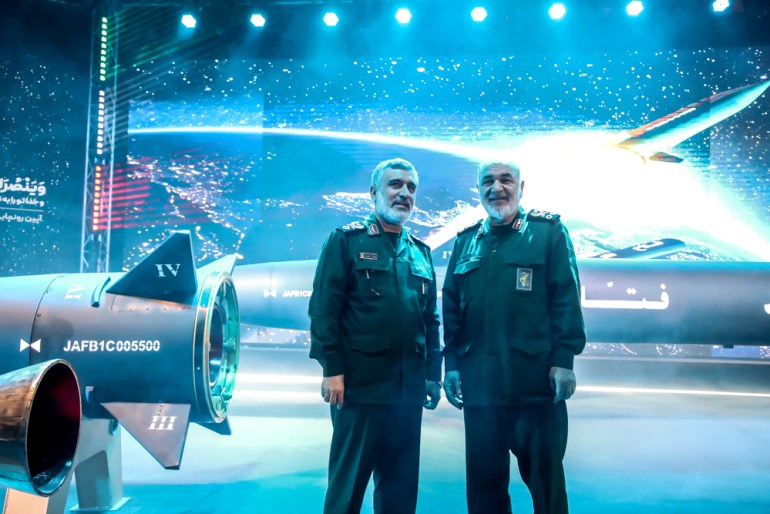Iran has a hypersonic missile. What does that mean?
Iran has dismissed scepticism over its development of hypersonic missiles, which could reach Israel in seven minutes.

Tehran, Iran – Iran has unveiled Fattah, a hypersonic ballistic missile it says is capable of breaching defence systems, which could cause further concerns for the West and Israel.
So, what are hypersonic missiles, who has them, what is the Iranian version capable of, and what’s the context of their unveiling?
Keep reading
list of 4 itemsIran says it is strong enough to defend regional waters
US bombs unlikely to reach underground Iran nuclear site: Report
What to expect after change of Iran’s top security official?
What are hypersonic missiles?
Hypersonic missiles are projectiles that can move at a speed of at least Mach 5, or five times the speed of sound. That is 1.7km (1.05 miles) per second or 6,174km (3,836 miles) per hour.
Some ballistic missiles already reach these speeds, but this new class of weapon separates itself from the pack as it can take a more random path to its intended target after plunging back into the earth’s atmosphere.
This makes it far more difficult to be detected by radar systems and to be destroyed by defence shields.
More countries are pursuing hypersonic weaponry in hopes they will provide them with a military edge, but the challenges remain formidable.
For one, friction from the upper atmosphere produces extremely high temperatures, while the intense speed of the missile produces superheated particles surrounding it that make it harder for radio communications to get through.
So far, Russia and China have displayed an array of hypersonic weapons, with Moscow being the only one thought to have tested them in combat. The United States has also tested hypersonic missiles but lags slightly behind its two rivals.

What does the Iranian missile look like?
Several months after the Islamic Revolutionary Guard Corps (IRGC) first announced in November that it had a hypersonic missile, the Fattah was displayed on Tuesday.
Iran says the projectile has a range of 1,400km (870 miles) and can move at a massive speed of up to Mach 15 (5.1 km or 3.2 miles per second) before hitting its target.
It is also said to feature a moveable secondary nozzle and employ solid propellants that allow for high manoeuvrability within and outside the atmosphere, which top IRGC commanders have claimed means no missile defence system in the world is a match for it.
Iranian authorities have also praised a “generational leap” in missile technology on the back of the Fattah, which they have said will give Iran new levels of deterrence.
They have dismissed Western scepticism of Iran’s development of hypersonic missiles, saying the truth will be revealed “on the day” such arms may be used, and that the US is only sceptical as the technology undermines its efforts to sell arms to the region.
🔰مجموعه تصاویر باکیفیت از موشک هایپرسونیک فتاح🔰 pic.twitter.com/MZRJxnIICx
— Mohammad Shaltouki | محمد شلتوکی (@mohshaltouki) June 6, 2023
Should Israel and the West be concerned?
Iran has refrained from directly threatening its arch foe Israel in unveiling its latest missile, as it had with some of its previous ones, but the signs are there.
Fattah’s current range is just short of the distance between Tehran and Tel Aviv, but IRGC aerospace chief commander Amir Ali Hajizadeh suggested on Tuesday that the elite force could look to hypersonics with a range of 2,000km (1,242 miles) in the near future.
That is a cap Iran has self-maintained for its expanding range of missiles to assuage Western, and particularly European, concerns about the reach of its projectiles.
At the claimed speeds, Fattah could theoretically reach Israeli targets in under seven minutes. That will leave little room for detection and interception, even for Israel’s Iron Dome missile defence system.
When covering news of the missile’s unveiling, Israeli media widely focused on a previous threat by Iranian media that an Iranian hypersonic projectile could reach Israel in 400 seconds.
Washington, for its part, did not directly comment on the hypersonic missile, but National Security Council official John Kirby said the Biden administration “has been very … firm on pushing back on Iran’s destabilising activities in the region, to include the development of an improving ballistic missile programme”.
The US also introduced a new round of sanctions on Tehran after the unveiling, including sanctions around its ballistic missile programme.
What’s the context?
Iran joins the limited ranks of countries with hypersonic weaponry at a time of significant political and military developments.
The country’s 2015 nuclear deal with world powers remains in limbo, but still alive, and the United Nations resolution underpinning it is set to lift some restrictions on the development of ballistic missiles in October.
Western powers continue to express concern over a growing military alliance between Tehran and Moscow.
Iran has been accused of supplying Russia with attack drones for its war in Ukraine, something it has denied. There have also been reports that Russia is looking to purchase Iranian missiles, but no such deal has been said to have been finalised.
But Iran has said it is looking to purchase advanced Sukhoi Su-35 fighter jets from Russia.
Meanwhile in the region, a China-brokered rapprochement between Iran and Saudi Arabia has opened the way for a flurry of diplomatic activity. Tehran officially reopened its embassy in Riyadh on Tuesday, and the kingdom is expected to follow suit shortly.
Speaking during Fattah’s unveiling on Tuesday, Iranian President Ebrahim Raisi sought to reassure neighbours of Tehran’s intentions, saying the missile marks a “point of sustainable peace and security” for the region.